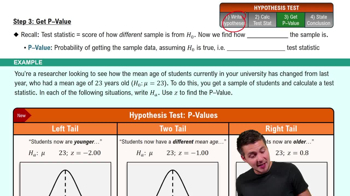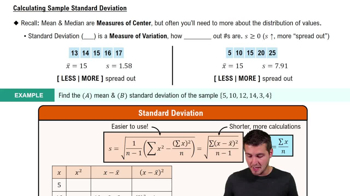Test Statistic and Critical Value The statistics for the sample data in Exercise 1 are n = 15, x_bar = 6.133333, and s = 8.862978, where the units are millions of dollars. Find the test statistic and critical value(s) for a test of the claim that the salaries are from a population with a mean greater than 5 million dollars. Assume that a 0.05 significance level is used.
Table of contents
- 1. Intro to Stats and Collecting Data1h 14m
- 2. Describing Data with Tables and Graphs1h 55m
- 3. Describing Data Numerically2h 5m
- 4. Probability2h 16m
- 5. Binomial Distribution & Discrete Random Variables3h 6m
- 6. Normal Distribution and Continuous Random Variables2h 11m
- 7. Sampling Distributions & Confidence Intervals: Mean3h 23m
- Sampling Distribution of the Sample Mean and Central Limit Theorem19m
- Distribution of Sample Mean - Excel23m
- Introduction to Confidence Intervals15m
- Confidence Intervals for Population Mean1h 18m
- Determining the Minimum Sample Size Required12m
- Finding Probabilities and T Critical Values - Excel28m
- Confidence Intervals for Population Means - Excel25m
- 8. Sampling Distributions & Confidence Intervals: Proportion1h 12m
- 9. Hypothesis Testing for One Sample3h 29m
- 10. Hypothesis Testing for Two Samples4h 50m
- Two Proportions1h 13m
- Two Proportions Hypothesis Test - Excel28m
- Two Means - Unknown, Unequal Variance1h 3m
- Two Means - Unknown Variances Hypothesis Test - Excel12m
- Two Means - Unknown, Equal Variance15m
- Two Means - Unknown, Equal Variances Hypothesis Test - Excel9m
- Two Means - Known Variance12m
- Two Means - Sigma Known Hypothesis Test - Excel21m
- Two Means - Matched Pairs (Dependent Samples)42m
- Matched Pairs Hypothesis Test - Excel12m
- 11. Correlation1h 6m
- 12. Regression1h 50m
- 13. Chi-Square Tests & Goodness of Fit1h 57m
- 14. ANOVA1h 57m
9. Hypothesis Testing for One Sample
Steps in Hypothesis Testing
Problem 8.4.8
Textbook Question
Testing Claims About Variation
In Exercises 5–16, test the given claim. Identify the null hypothesis, alternative hypothesis, test statistic, P-value, or critical value(s), then state the conclusion about the null hypothesis, as well as the final conclusion that addresses the original claim. Assume that a simple random sample is selected from a normally distributed population.
Birth Weights A simple random sample of birth weights of 30 girls has a standard deviation of 829.5 g. Use a 0.01 significance level to test the claim that birth weights of girls have the same standard deviation as birth weights of boys, which is 660.2 g (based on Data Set 6 “Births” in Appendix B).
 Verified step by step guidance
Verified step by step guidance1
Step 1: Define the null hypothesis (H₀) and the alternative hypothesis (H₁). The null hypothesis states that the standard deviation of birth weights for girls is equal to that of boys (σ = 660.2 g). The alternative hypothesis states that the standard deviation of birth weights for girls is not equal to that of boys (σ ≠ 660.2 g).
Step 2: Identify the test statistic to use. Since this is a test about the population standard deviation, use the chi-square test for variance. The test statistic is given by the formula: χ² = ((n - 1) * s²) / σ₀², where n is the sample size, s is the sample standard deviation, and σ₀ is the hypothesized population standard deviation.
Step 3: Calculate the degrees of freedom (df). The degrees of freedom for the chi-square test is given by df = n - 1, where n is the sample size. In this case, n = 30, so df = 30 - 1 = 29.
Step 4: Determine the critical value(s) or P-value. Since this is a two-tailed test (σ ≠ 660.2 g), find the critical chi-square values for a significance level of 0.01 and df = 29. Use a chi-square distribution table or statistical software to find these values. Alternatively, calculate the P-value based on the test statistic.
Step 5: Compare the test statistic to the critical value(s) or compare the P-value to the significance level (α = 0.01). If the test statistic falls outside the range of the critical values or if the P-value is less than 0.01, reject the null hypothesis. Otherwise, fail to reject the null hypothesis. State the conclusion in the context of the problem: whether there is sufficient evidence to support the claim that the standard deviation of birth weights for girls is different from that of boys.
 Verified video answer for a similar problem:
Verified video answer for a similar problem:This video solution was recommended by our tutors as helpful for the problem above
Video duration:
5mPlay a video:
Was this helpful?
Key Concepts
Here are the essential concepts you must grasp in order to answer the question correctly.
Hypothesis Testing
Hypothesis testing is a statistical method used to make decisions about a population based on sample data. It involves formulating two competing hypotheses: the null hypothesis (H0), which represents a statement of no effect or no difference, and the alternative hypothesis (H1), which indicates the presence of an effect or difference. The goal is to determine whether there is enough evidence in the sample data to reject the null hypothesis in favor of the alternative.
Recommended video:
Guided course

Step 1: Write Hypotheses
P-value
The P-value is a measure that helps determine the strength of the evidence against the null hypothesis. It represents the probability of obtaining a test statistic at least as extreme as the one observed, assuming that the null hypothesis is true. A smaller P-value indicates stronger evidence against the null hypothesis, and if it is less than the predetermined significance level (e.g., 0.01), the null hypothesis is rejected.
Recommended video:
Guided course

Step 3: Get P-Value
Standard Deviation and Variance
Standard deviation is a statistic that quantifies the amount of variation or dispersion in a set of data values. It is the square root of the variance, which measures the average squared deviation of each data point from the mean. In hypothesis testing, comparing the standard deviations of two groups (e.g., birth weights of girls and boys) can help assess whether there is a significant difference in variability between the two populations.
Recommended video:
Guided course

Calculating Standard Deviation

 6:21m
6:21mWatch next
Master Step 1: Write Hypotheses with a bite sized video explanation from Patrick
Start learningRelated Videos
Related Practice
Textbook Question
